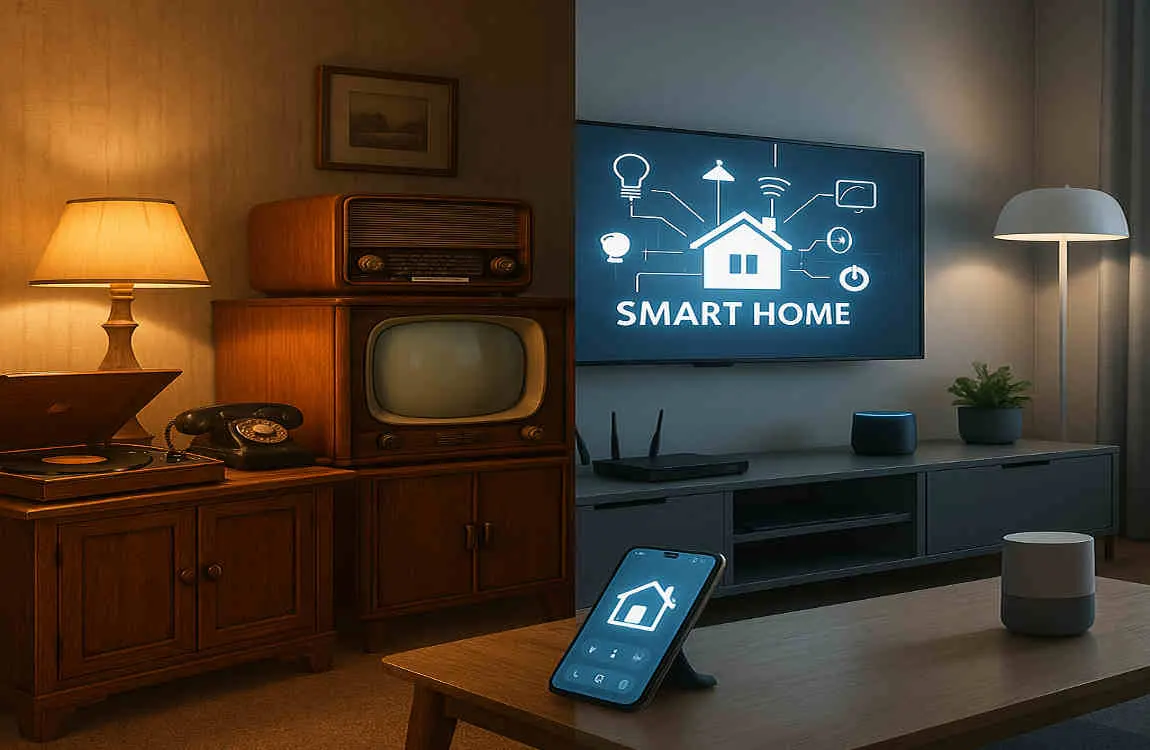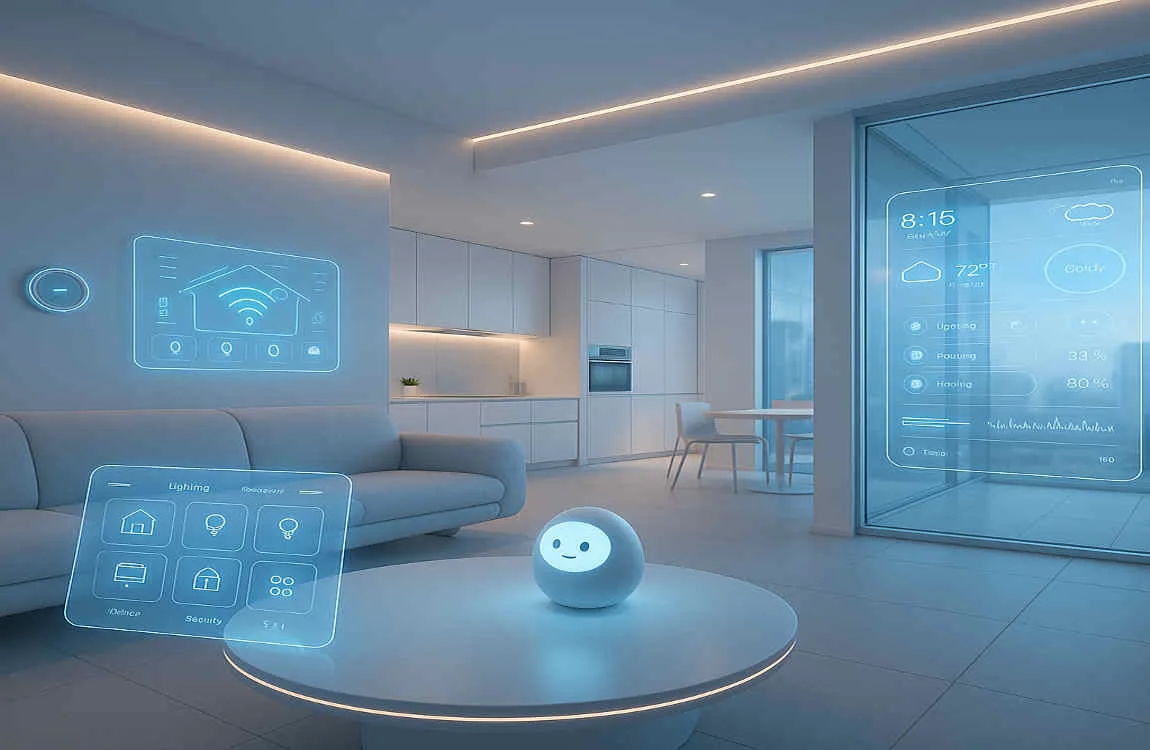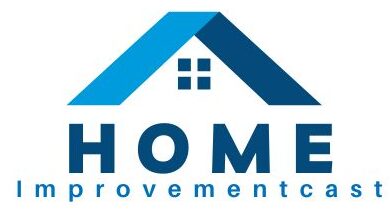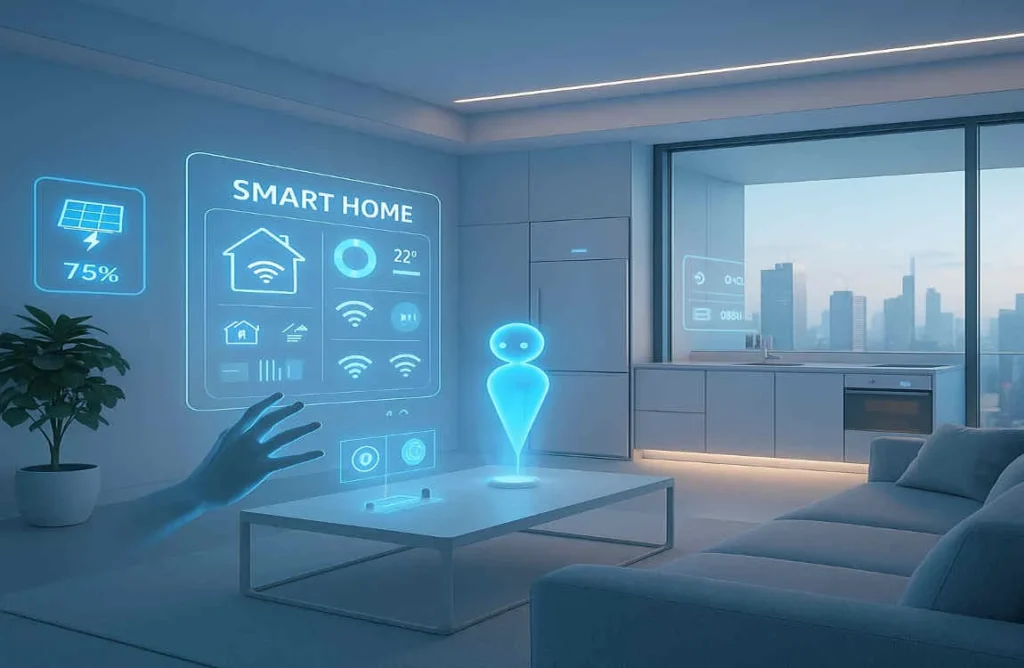Have you ever wondered what your home might look like in just a few years? The world of future home technology is evolving at breakneck speed, transforming our living spaces into intelligent, responsive environments that seem straight out of science fiction. Yet, these innovations aren’t just fantasies anymore—they’re rapidly becoming reality.
Staying informed about emerging home technology trends isn’t just exciting; it’s becoming essential for both homeowners and businesses. Whether you’re planning to upgrade your living space or looking for investment opportunities in the tech sector, understanding the future of home technology can give you a significant advantage.
The smart home market is experiencing explosive growth. Industry experts project that the global smart home technology market will reach a staggering $135 billion by 2025
Evolution of Home Technology: Past to Present

Remember when a programmable thermostat was considered cutting-edge home technology? Those days feel like ancient history now. The journey from basic automation to today’s intelligent homes has been nothing short of revolutionary.
The early days of home technology were simple. We had clunky remote controls, basic security systems, and perhaps a programmable coffee maker if we were feeling fancy. These devices operated in isolation, each with its own controls and no ability to communicate with other household gadgets.
Then came the Internet of Things (IoT) revolution. Suddenly, our devices could talk to each other and to us through the internet. This connectivity transformed isolated gadgets into an interconnected ecosystem. Your thermostat could now check the weather forecast, your lights could respond to your daily schedule, and your security system could send alerts directly to your smartphone.
Artificial Intelligence took this evolution to the next level. No longer were our homes just connected—they became intelligent. AI-enabled devices to learn from our behaviours, predict our needs, and make decisions autonomously. Your home started understanding when you typically arrive from work, what temperature you prefer for sleeping, and which lights you like on during movie night.
Today’s smart homes represent a mainstream phenomenon. What was once the domain of tech enthusiasts has become accessible to average homeowners. Voice assistants like Alexa and Google Assistant have found their way into millions of homes. Smart doorbells, thermostats, and lighting systems are now standard offerings in many new constructions.
Yet, we’re still just scratching the surface. The current state of smart homes, impressive as it may be, is merely the foundation for what’s coming next.
Key Trends in Future Home Technology
AI-Powered Smart Assistants and Automation
The future of home technology is being shaped by artificial intelligence in ways that would have seemed impossible just a decade ago. Today’s AI-powered assistants are evolving from simple voice-activated helpers into sophisticated systems that truly understand and anticipate your needs.
You may also read (what is the best way to stain house plywood).
Modern AI assistants are becoming remarkably perceptive. They’re learning to recognise patterns in your daily life that you might even overlook. Does your morning routine change on Wednesdays because of that early meeting? Your AI assistant will adjust your alarm, start the coffee maker earlier, and have your bathroom heated to the perfect temperature—all without being asked.
Take the Google Nest Learning Thermostat, for example. This isn’t just a programmable device; it’s an AI system that observes your temperature preferences throughout the day and across seasons. Within a week, it creates a personalised schedule that maximises both comfort and energy efficiency. Users report average energy savings of 10-23% on heating and cooling bills.
Voice assistants like Alexa and Google Assistant are also becoming more conversational and context-aware. They’re moving beyond simple command-response interactions to understanding follow-up questions and maintaining conversation context. You can now say, “Turn on the living room lights,” followed by “Make them warmer,” and your assistant understands precisely what you mean.
The real magic happens with predictive maintenance. AI-powered home systems can now detect when appliances are beginning to fail before they actually break down. Your smart home might alert you that your HVAC system is showing signs of strain, suggesting maintenance before you’re left without heating on the coldest day of winter.
These AI systems are also becoming energy-conscious partners. They learn when electricity rates are lowest, when solar panels are generating excess power, and when to run high-energy appliances for maximum efficiency. This intelligence translates directly into lower utility bills and a reduced carbon footprint.
Universal Smart Home Connectivity With Matter Protocol
One of the biggest frustrations with smart home technology has been the compatibility nightmare. You buy a bright light bulb that works with Alexa, a thermostat designed for Google Home, and a door lock that only talks to Apple HomeKit. Getting them all to work together? Good luck with that.
Enter Matter, the game-changing protocol that’s finally solving this fragmentation problem. Think of Matter as a universal translator for smart home devices. It’s not just another standard competing for attention—it’s backed by the biggest names in tech: Apple, Google, Amazon, and Samsung are all on board.
Why does this matter to you? Imagine walking into a store and buying any smart device without worrying about whether it’ll work with your existing setup. That’s the promise of Matter. You won’t need multiple apps to control different devices or worry about being locked into one ecosystem.
The security benefits are equally impressive. Matter uses advanced encryption and authentication methods, ensuring that your smart home devices are protected against hacking. Every device must meet strict security standards before earning Matter certification, giving you peace of mind about your connected home.
Real products are already hitting the market. Philips Hue lighting systems now support Matter, meaning they work seamlessly whether you prefer Siri, Alexa, or Google Assistant. Yale’s smart locks with Matter support let you control access to your home through any central platform. Even Amazon’s Echo devices are getting Matter updates, transforming them into universal smart home hubs.
Setting up Matter devices is refreshingly simple. Gone are the days of complicated pairing processes and compatibility checks. With Matter, you typically just scan a QR code, and your device is ready to go. It automatically works with all your existing Matter-compatible systems.
This universal connectivity extends beyond convenience. It’s creating a more competitive market where manufacturers focus on making better products rather than locking users into proprietary ecosystems. For consumers, this means more choices, better prices, and innovative features.
Advanced Smart Home Security Solutions
Home security has evolved far beyond simple alarms and basic cameras. Today’s AI-powered security systems are transforming homes into intelligent fortresses that can distinguish between real threats and false alarms with remarkable accuracy.
Facial recognition technology has become a game-changer in home security. Modern security cameras don’t just detect motion—they recognise who’s approaching your door. Is it your teenager coming home from school, the regular delivery person, or an unknown visitor? Your system knows the difference and responds accordingly.
These intelligent systems are dramatically reducing false alarms. Traditional motion sensors might alert you every time a cat walks by or a tree branch moves in the wind. AI-powered cameras understand context. They can tell the difference between a person approaching your door and a plastic bag blowing across your porch.
Biometric security is becoming increasingly common in residential settings. Smart locks now feature fingerprint readers that are as sophisticated as those on high-end smartphones. Some systems even use facial recognition for entry, creating a truly keyless experience while maintaining bank-level security.
The integration with emergency services has become seamless and intelligent. If your security system detects a break-in, it doesn’t just sound an alarm—it can automatically contact police, send them real-time video feeds, and even provide detailed information about which areas of your home have been breached.
Cloud-based security platforms are enabling unprecedented remote monitoring capabilities. You can check on your home from anywhere in the world, receive intelligent alerts about unusual activity, and even communicate with visitors through two-way audio systems. Some platforms use AI to learn your family’s routines and only alert you when something truly unusual occurs.
Advanced systems are also incorporating environmental monitoring. They detect not just intruders but also smoke, carbon monoxide, water leaks, and even unusual temperature changes that might indicate a fire. This comprehensive approach turns your security system into a complete home protection solution.
5G and Faster Smart Home Connectivity
The rollout of 5G networks is set to revolutionise smart home technology in ways that go far beyond faster download speeds. This next-generation connectivity is eliminating the bottlenecks that have held back truly responsive home automation.
With 5G, latency becomes virtually non-existent. When you tell your smart home to turn off the lights, the response is instantaneous. This might seem like a slight improvement, but it fundamentally changes how we interact with our homes. Real-time automation becomes truly real-time.
The increased bandwidth of 5G networks means your home can support many more connected devices without any slowdown. While current home networks might struggle with 20 or 30 smart devices, 5G-enabled homes can easily handle hundreds of connected gadgets, all operating simultaneously without interference.
This connectivity upgrade is enabling new experiences that weren’t possible before. Augmented reality (AR) and virtual reality (VR) applications require massive amounts of data transfer with minimal delay. With 5G, you could redesign your living room using AR, seeing virtual furniture in your actual space in real-time, or attend a VR meeting from your home office that feels as real as being there in person.
Samsung’s SmartThings hub with 5G integration showcases what’s possible. It can process complex automation routines locally while maintaining cloud connectivity for advanced features. This hybrid approach means your smart home keeps working even if your internet connection fails, while still benefiting from cloud-based AI and updates when connected.
The implications for multimedia integration are equally exciting. 5G enables seamless 4K and even 8K video streaming to multiple devices simultaneously. Your smart home can support high-definition video calls on your TV, security camera feeds on your tablet, and music streaming throughout your house—all without any buffering or quality loss.
Sustainability and Energy Efficiency in Future Homes
The future of home technology is increasingly green and sustainable. As climate concerns grow and energy costs rise, smart homes are becoming powerful tools for reducing both environmental impact and utility bills.
Energy monitoring systems have evolved from simple meters to intelligent advisors. Modern systems track energy usage in real-time, identifying which devices consume the most power and suggesting optimisations. They can even predict your monthly bill and recommend changes to stay within budget.
Solar integration has become seamlessly smart. The Tesla Solar Roof and Powerwall combination exemplifies this trend. These systems don’t just generate and store solar energy—they intelligently manage it. They know when to store power, when to use it, and when to sell excess back to the grid for maximum financial benefit.
Intelligent irrigation systems are revolutionising water conservation. These systems check weather forecasts, monitor soil moisture, and understand plant water needs. They can skip watering before rain, adjust schedules based on seasonal changes, and even detect leaks in your irrigation system. Users typically see 20-50% reductions in water usage.
AI-powered optimisation goes beyond individual devices. Whole-home energy management systems coordinate all your smart devices to minimise energy waste. They might pre-cool your home when electricity rates are low, run your dishwasher when solar generation peaks, or automatically adjust lighting based on natural daylight levels.
The financial benefits are compelling. Homeowners with comprehensive innovative energy systems report average savings of 20-30% on their utility bills. Over time, these savings can completely offset the cost of the smart home technology itself.
Businesses are taking notice, too. The growing consumer demand for sustainable home technology is creating new opportunities for companies that can deliver eco-friendly solutions. From innovative insulation that adjusts based on weather conditions to windows that tint automatically to reduce cooling needs, innovation in sustainable home tech is accelerating.
Innovative Kitchens and Home Appliances
The kitchen is becoming the most intelligent room in the house. AI-enabled appliances are transforming cooking from a chore into an assisted creative experience, while clever storage solutions are eliminating food waste and simplifying meal planning.
You may also read (renovating your home why natural stone is the right choice for floors and coverings).
Smart refrigerators have evolved into command centres for your kitchen. The LG InstaView refrigerator, for instance, lets you see inside without opening the door, tracks expiration dates, and suggests recipes based on what you have. It can even order groceries automatically when you’re running low on essentials.
AI-powered cooking is making gourmet meals accessible to everyone. Smart ovens can recognise what you’re cooking, suggest optimal settings, and adjust temperature and timing automatically. Some can even learn your preferences—how you like your steak cooked or how crispy you want your roasted vegetables.
Voice-controlled appliances are becoming standard. Imagine saying, “Make my morning coffee,” and having your coffee maker prepare your usual order while you’re still in bed. Or asking your oven to preheat for pizza while your hands are covered in flour. This hands-free control is particularly valuable when cooking gets messy.
The integration with grocery delivery services creates a seamless food ecosystem. Your smart fridge can add items to your shopping list, your meal planning app can order ingredients for the week’s recipes, and your smart doorbell can grant access to delivery services even when you’re not home.
Health and Wellness Technologies in Homes
Our homes are becoming personal wellness centres, equipped with technology that monitors and improves our health around the clock. These innovations go beyond fitness trackers, creating living environments that actively contribute to our wellbeing.
Smart air purifiers now do more than clean the air—they monitor air quality in real-time, adjust their operation based on pollution levels, and can even integrate with your HVAC system for whole-home air quality management. They track allergens, volatile organic compounds (VOCs), and particulate matter, providing detailed reports about your indoor air quality.
Sleep optimisation has become a significant focus. The Eight Sleep innovative mattress, for example, adjusts temperature throughout the night to optimise sleep cycles, tracks sleep quality, and can even wake you during your lightest sleep phase for more leisurely mornings. Some systems integrate with bright lighting to simulate a natural sunrise for gentler wake-ups.
Fitness mirrors and interactive workout systems are bringing the gym experience home. These devices offer personalised training sessions, real-time form correction, and progress tracking. They’re turning spare bedrooms and basements into sophisticated home gyms that rival professional facilities.
Emerging and Future Innovations in Home Technology

The next wave of home technology promises innovations that sound like pure science fiction today. Yet, these emerging technologies are closer to reality than you might think.
Emotionally intelligent AI is perhaps the most intriguing development. Future home assistants won’t just recognise what you say—they’ll understand how you feel. They might detect stress in your voice and automatically dim lights, play calming music, or adjust the room temperature to help you relax. This emotional awareness could transform our homes into truly responsive environments that support our mental wellbeing.
Augmented Reality (AR) is set to revolutionise how we interact with our living spaces. Imagine pointing your phone at a wall and seeing virtual art that changes based on your mood, or looking at your empty kitchen counter and viewing a holographic cooking instructor guiding you through a recipe. AR glasses could overlay useful information throughout your home—showing the temperature when you look at the thermostat or displaying recipe instructions floating above your stove.
Virtual Reality (VR) will transform spare rooms into infinite spaces. One moment, your home office could be a virtual beach resort for a relaxing work session; the next, it could become a collaborative workspace where you meet with colleagues from around the world as if they were sitting across from you.
The integration of smart homes with smart cities represents another frontier. Your home will communicate with the city infrastructure to optimise everything from energy usage to traffic patterns. Your smart car might tell your home when you’re 10 minutes away, triggering a sequence that prepares your arrival—adjusting temperature, starting dinner preparation, and queuing up your evening entertainment.
Edge computing will make smart homes faster and more reliable. Instead of sending all data to the cloud, future homes will process much of the information locally. This means quicker response times, better privacy, and continued functionality even if internet connectivity is lost.
Looking further ahead, quantum computing might enable smart homes that can solve incredibly complex optimisation problems instantly. Imagine a home that can simultaneously optimise energy usage, comfort, security, and cost across thousands of variables in real-time.
Business Implications and Opportunities
The rapid evolution of future home technology is creating unprecedented opportunities for businesses willing to innovate and adapt. The smart home market isn’t just growing—it’s fundamentally reshaping multiple industries.
For technology companies, the imperative is clear: invest in AI, 5G capabilities, and sustainability, or risk being left behind. The companies that can successfully integrate these technologies while maintaining user-friendly interfaces will capture the largest market share. The projected $135 billion market by 2025 represents just the beginning of this opportunity.
Startups have unique advantages in this space. They can move quickly to address specific pain points that larger companies might overlook. Whether it’s developing niche AI applications, creating innovative sustainable solutions, or building bridges between different smart home ecosystems, agile startups can carve out profitable niches.
Established firms need to embrace interoperability standards like Matter. The days of trying to lock consumers into proprietary ecosystems are ending. Companies that open their platforms and focus on creating the best possible products will build stronger, more loyal customer bases.
The emphasis on sustainability is creating entirely new business categories. Companies that can demonstrate real environmental benefits alongside cost savings will find eager markets. From energy management systems to water conservation technologies, green innovation is becoming a key differentiator.
You may also read (what is the best homemade upholstery cleaner for stains).

